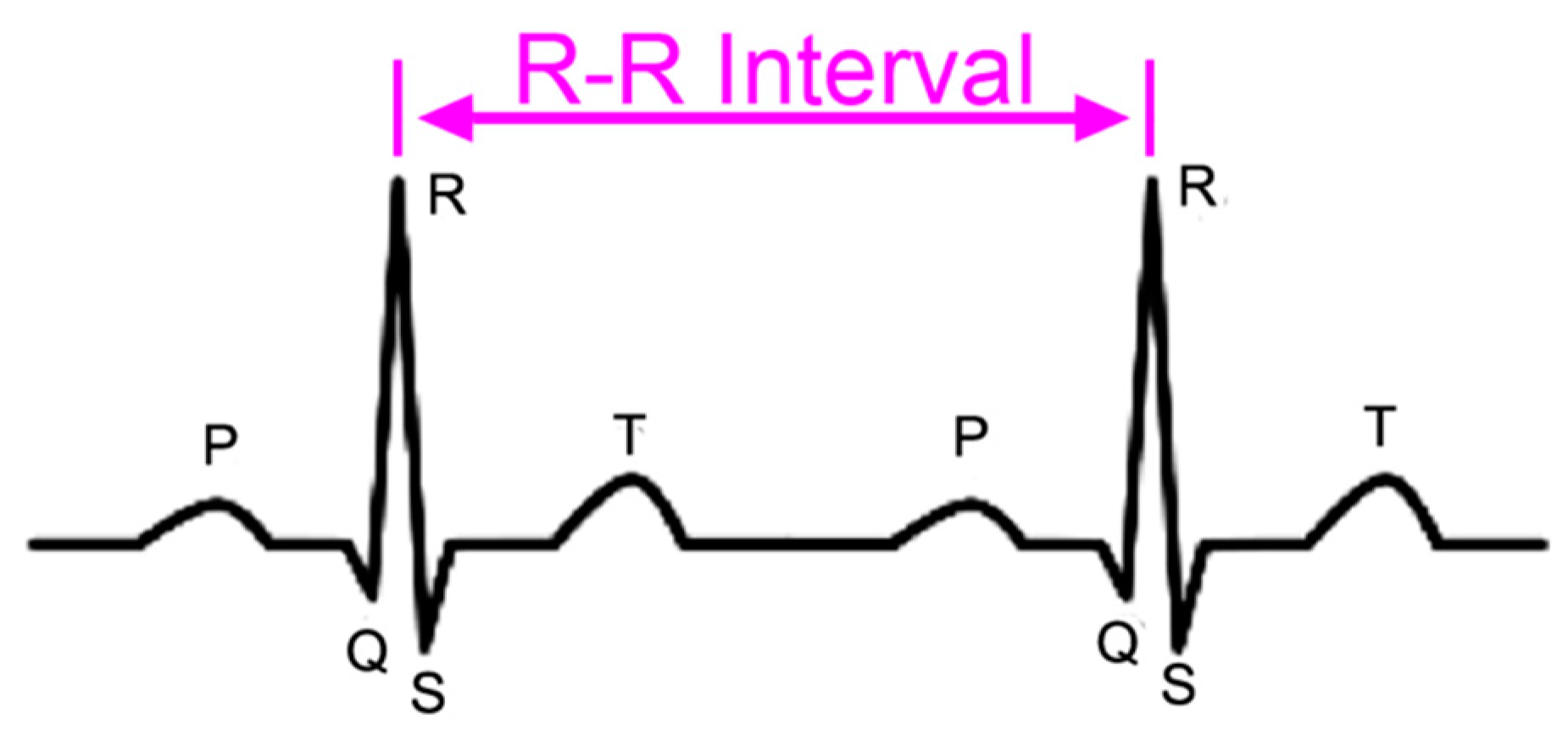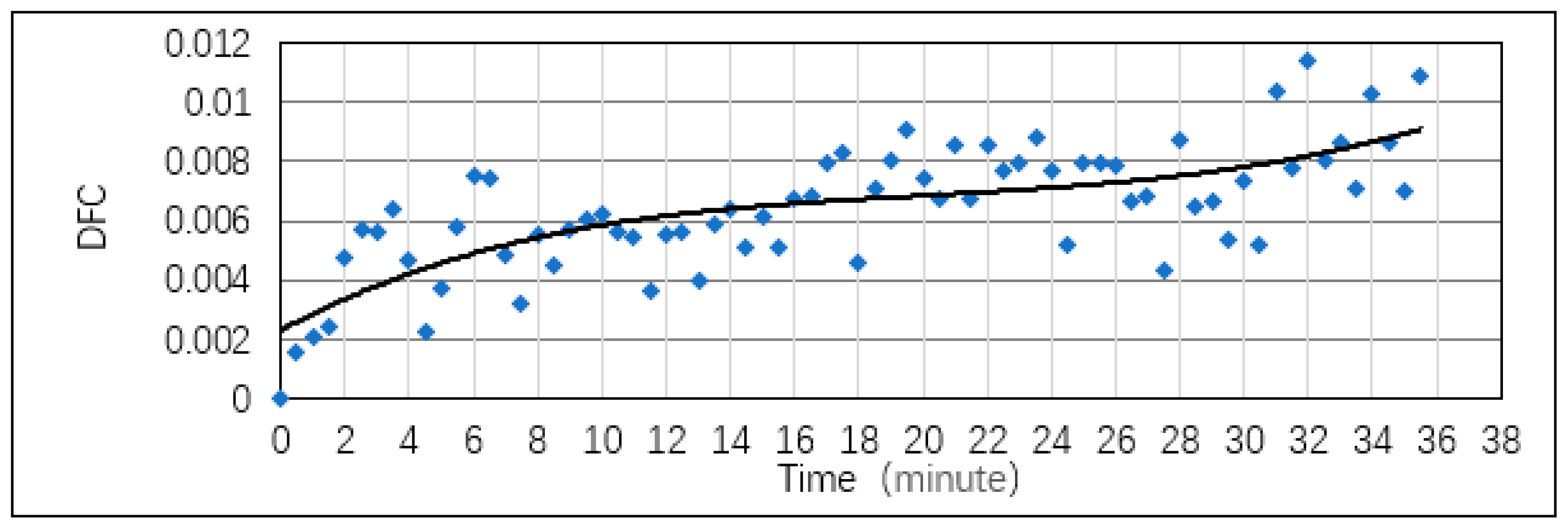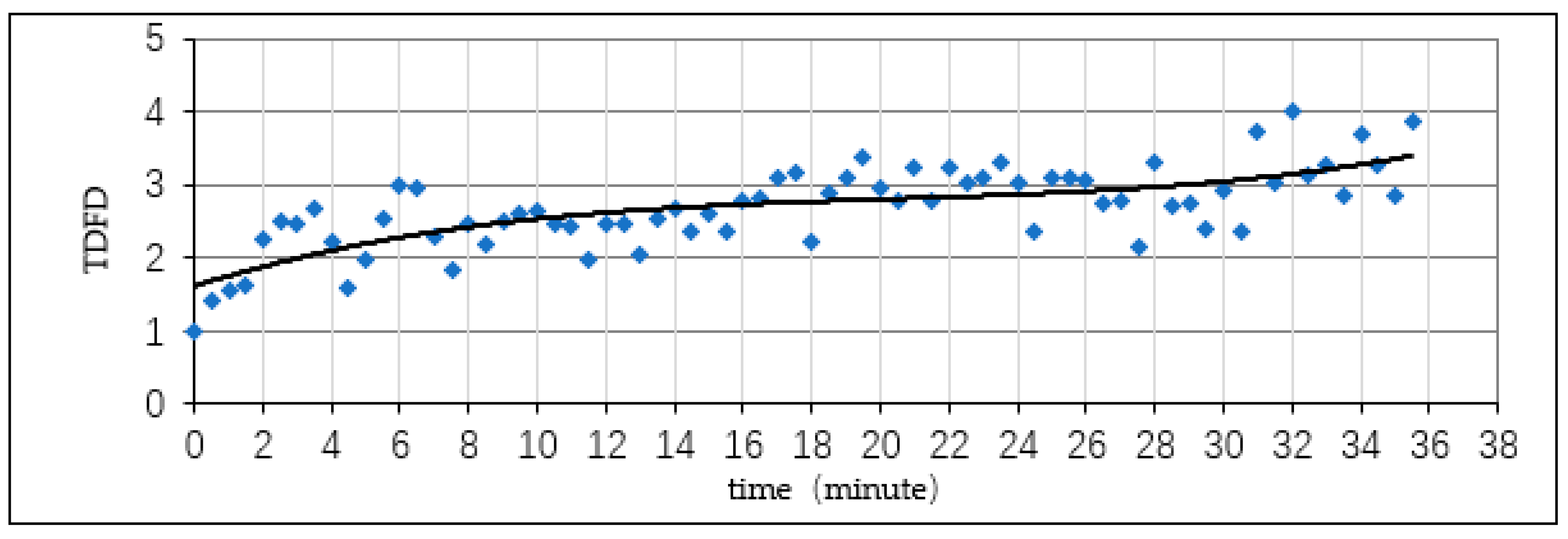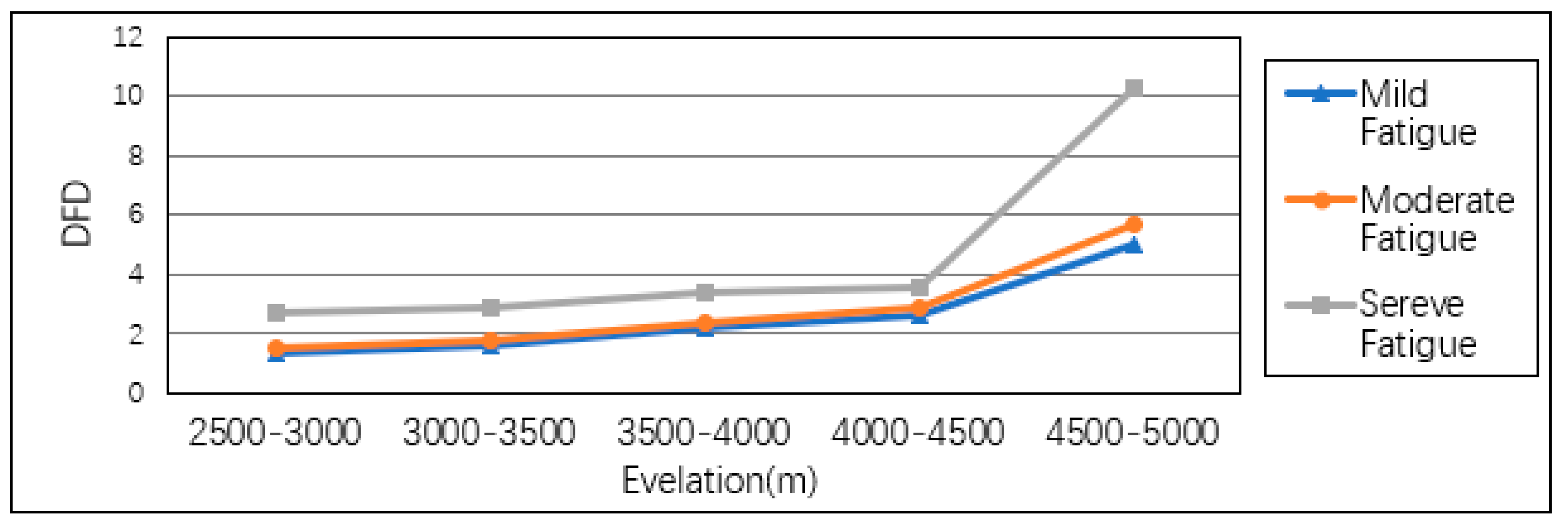Classification of Driving Fatigue in High-Altitude Areas
Abstract
:1. Introduction
2. Methodology
2.1. Participants
2.2. Instruments
2.3. Procedures
2.4. Data Collection
- (1)
- Process the ECG data obtained in the experiment to its corresponding R–R interval series with different elevations,
- (2)
- Calculate the standard deviation of NN intervals (SDNN) and mean of R–R interval series every 30 s, N is the number of R–R interval in 30 s, that is:
- (3)
- Calculate the variable coefficient of RR interval series, that is, RRVC, every 30 s:
3. Results
4. Conclusions
Author Contributions
Funding
Acknowledgments
Conflicts of Interest
References
- World Health Organization. Global Status Report on Road Safety 2015; World Health Organization: Geneva, Switzerland, 2015. [Google Scholar]
- Maycock, G. Sleepiness and driving: The experience of UK car drivers. Accid. Anal. Prev. 1997, 29, 453–462. [Google Scholar] [CrossRef]
- Fletcher, A.; McCulloch, K.; Baulk, S.D.; Dawson, D. Countermeasures to driver fatigue: A review of public awareness campaigns and legal approaches. Aust. N. Z. J. Public Health 2005, 29, 471–476. [Google Scholar] [CrossRef] [PubMed]
- Shahly, V.; Berglund, P.A.; Coulouvrat, C.; Fitzgerald, T.; Hajak, G.; Roth, T.; Shillington, A.C.; Stephenson, J.J.; Walsh, J.K.; Kessler, R.C. The associations of insomnia with costly workplace accidents and errors: Results from the America Insomnia Survey. Arch. Gen. Psychiatry 2012, 69, 1054–1063. [Google Scholar] [CrossRef] [PubMed]
- Williamson, A.M.; Feyer, A.; Friswell, R. The impact of work practices on fatigue in long distance truck drivers. Accid. Anal. Prev. 1996, 28, 709–719. [Google Scholar] [CrossRef]
- Di Stasi, L.L.; Renner, R.; Catena, A.; Cañas, J.J.; Velichkovsky, B.M.; Pannasch, S. Towards a driver fatigue test based on the saccadic main sequence: A partial validation by subjective report data. Transp. Res. Part C Emerg. Technol. 2012, 21, 122–133. [Google Scholar] [CrossRef]
- Dawson, D. Fatigue research in 2011: From the bench to practice. Accid. Anal. Prev. 2012, 45, 1–5. [Google Scholar] [CrossRef] [PubMed]
- Lal, S.K.; Craig, A. A critical review of the psychophysiology of driver fatigue. Biol. Psychol. 2001, 55, 173–194. [Google Scholar] [CrossRef]
- Riemersma, J.B.J.; Sanders, A.F.; Hildervanck, C.; Gaillard, A.W. Performance decrement during prolonged night driving. In Vigilance: Theory, Operational Performance and Physiological Correlates; Mackie, R., Ed.; Plenum Press: New York, NY, USA, 1977; pp. 41–58. [Google Scholar]
- Lal, S.K.L.; Craig, A. Driver Fatigue: Psychophysiological effects. In Proceedings of the Fourth International Conference on Fatigue and Transportation, Fremantle, Australia, 19 March 2000. [Google Scholar]
- Harris, W.; Mackie, R.R.; Abrams, C.; Buckner, D.N.; Harabedian, A.; O’Hanlon, J.F.; Starks, J.R. A study of the Relationship Among Fatigue, Hours of Service and Safety of Operations of Truck- and Bus-Drivers; Human Factors Research Inc.: Carlsbad, CA, USA, 1972. [Google Scholar]
- O’Hanlon, J.F. Heart Rate Variability; A New Index of Drivers’ Alertness: Fatigue; Human Factors Research Inc.: Carlsbad, CA, USA, 1971. [Google Scholar]
- Hartley, L.R.; Arnold, P.K. Indicators of fatigue in truck drivers. Appl. Ergon. 1994, 25, 143–156. [Google Scholar] [CrossRef]
- Lal, S.; Craig, A.; Boord, P.; Kirkup, L.; Nguyen, H. Development of an algorithm for an EEG-based driver fatigue countermeasure. J. Saf. Res. 2003, 34, 321–328. [Google Scholar] [CrossRef]
- Patel, M.; Lal, S.K.L.; Rossiter, P.; Kavanagh, D. Applying neural network analysis on heart rate variability data to assess driver fatigue. Expert Syst. Appl. 2011, 38, 7235–7242. [Google Scholar] [CrossRef]
- Lenne, M.G.; Triggs, T.J.; Redman, J.R. Time of day variation in driving performance. Accid. Anal. Prev. 1997, 29, 431–437. [Google Scholar] [CrossRef]
- Williamson, A.; Lombardi, D.A.; Folkard, S.; Stutts, J.; Courtney, T.K.; Connorf, J.L. The link between fatigue and safety. Accid. Anal. Prev. 2011, 43, 498–515. [Google Scholar] [CrossRef] [PubMed]
- Grace, P.M.; Stanford, T.; Gentgall, M.; Rolan, P.E. Utility of saccadic eye movement analysis as an objective biomarker to detect the sedative interaction between opioids and sleep deprivation in opioid-naïve and opioid-tolerant populations. J. Psychopharmacol. 2010, 1631–1640. [Google Scholar] [CrossRef] [PubMed]
- Merat, N.; Jamson, A.H. The effect of three low-cost engineering treatments on driver fatigue: A driving simulator study. Accid. Anal. Prev. 2013, 50, 8–15. [Google Scholar] [CrossRef] [PubMed]








| Time (min) | SDNN (ms) | M (ms) | RRVC | DFC | TDFD | DFD | |
|---|---|---|---|---|---|---|---|
| Resting | 1.12199 | 556.8667 | 0.002015 | 0.003802 | |||
| Initial | 0 | 3.53244 | 607.2667 | 0.005817 | 0 | 1 | 0 |
| 0.5 | 4.36759 | 592.6 | 0.00737 | 0.001553 | 1.408526 | 0.408526 | |
| 1 | 4.55313 | 576.4 | 0.007899 | 0.002082 | 1.547673 | 0.547673 | |
| 1.5 | 4.82232 | 584.3333 | 0.008253 | 0.002436 | 1.640633 | 0.640633 | |
| 2 | 5.93392 | 559.8667 | 0.010599 | 0.004782 | 2.257709 | 1.257709 | |
| 2.5 | 6.48636 | 562.7667 | 0.011526 | 0.005709 | 2.501537 | 1.501537 | |
| 3 | 6.57991 | 576.4333 | 0.011415 | 0.005598 | 2.472348 | 1.472348 | |
| 3.5 | 6.98936 | 570.7667 | 0.012246 | 0.006429 | 2.690837 | 1.690837 | |
| 4 | 5.90353 | 563.1 | 0.010484 | 0.004667 | 2.227507 | 1.227507 | |
| 4.5 | 4.54404 | 564.2 | 0.008054 | 0.002237 | 1.588362 | 0.588362 | |
| 5 | 5.42461 | 570.4333 | 0.00951 | 0.003693 | 1.971234 | 0.971234 | |
| 5.5 | 6.62211 | 571.2 | 0.011593 | 0.005776 | 2.519287 | 1.519287 | |
| 6 | 7.66159 | 573.3 | 0.013364 | 0.007547 | 2.985012 | 1.985012 | |
| 6.5 | 7.51617 | 567.1667 | 0.013252 | 0.007435 | 2.955585 | 1.955585 | |
| 7 | 6.04176 | 566.2 | 0.010671 | 0.004854 | 2.276622 | 1.276622 | |
| 7.5 | 5.11487 | 569.6667 | 0.008979 | 0.003162 | 1.83159 | 0.83159 | |
| 8 | 6.59771 | 580.5667 | 0.011364 | 0.005547 | 2.459037 | 1.459037 | |
| 8.5 | 5.92607 | 576.7667 | 0.010275 | 0.004458 | 2.172446 | 1.172446 | |
| 9 | 6.65949 | 578.7667 | 0.011506 | 0.005689 | 2.496409 | 1.496409 | |
| 9.5 | 6.86635 | 578.5 | 0.011869 | 0.006052 | 2.591854 | 1.591854 | |
| 10 | 6.86885 | 571.5333 | 0.012018 | 0.006201 | 2.631059 | 1.631059 | |
| 10.5 | 6.63177 | 579 | 0.011454 | 0.005637 | 2.482597 | 1.482597 | |
| 11 | 6.51367 | 576.6 | 0.011297 | 0.00548 | 2.441264 | 1.441264 | |
| 11.5 | 5.37574 | 567.7667 | 0.009468 | 0.003651 | 1.960342 | 0.960342 | |
| 12 | 7.05363 | 621.6333 | 0.011347 | 0.00553 | 2.454479 | 1.454479 | |
| 12.5 | 6.92907 | 608.1667 | 0.011393 | 0.005576 | 2.466695 | 1.466695 | |
| 13 | 5.90466 | 604.3667 | 0.00977 | 0.003953 | 2.039715 | 1.039715 | |
| 13.5 | 6.73119 | 575.7667 | 0.011691 | 0.005874 | 2.544931 | 1.544931 | |
| 14 | 7.61524 | 622.0667 | 0.012242 | 0.006425 | 2.689858 | 1.689858 | |
| 14.5 | 6.86269 | 626.4 | 0.010956 | 0.005139 | 2.351595 | 1.351595 | |
| Mild fatigue | 15 | 7.20002 | 601.2333 | 0.011975 | 0.006158 | 2.619784 | 1.619784 |
| 15.5 | 6.35867 | 580.4333 | 0.010955 | 0.005138 | 2.351405 | 1.351405 | |
| 16 | 7.32496 | 581.7 | 0.012592 | 0.006775 | 2.782044 | 1.782044 | |
| 16.5 | 7.59014 | 598.8667 | 0.012674 | 0.006857 | 2.80357 | 1.80357 | |
| 17 | 8.44728 | 614.1667 | 0.013754 | 0.007937 | 3.087599 | 2.087599 | |
| 17.5 | 8.40259 | 597.5 | 0.014063 | 0.008246 | 3.168835 | 2.168835 | |
| 18 | 6.40334 | 614.7333 | 0.010416 | 0.004599 | 2.209745 | 1.209745 | |
| 18.5 | 7.67029 | 592.8333 | 0.012938 | 0.007121 | 2.873056 | 1.873056 | |
| 19 | 8.31485 | 600.6333 | 0.013843 | 0.008026 | 3.111118 | 2.111118 | |
| 19.5 | 8.98899 | 604.9 | 0.01486 | 0.009043 | 3.378562 | 2.378562 | |
| 20 | 8.01774 | 605.3 | 0.013246 | 0.007429 | 2.953944 | 1.953944 | |
| 20.5 | 7.54572 | 601.6 | 0.012543 | 0.006726 | 2.769004 | 1.769004 | |
| 21 | 8.45713 | 588.8333 | 0.014363 | 0.008546 | 3.247638 | 2.247638 | |
| 21.5 | 7.74697 | 617.2333 | 0.012551 | 0.006734 | 2.771205 | 1.771205 | |
| 22 | 8.80236 | 613.3667 | 0.014351 | 0.008534 | 3.24458 | 2.24458 | |
| 22.5 | 8.07429 | 596.9333 | 0.013526 | 0.007709 | 3.027692 | 2.027692 | |
| 23 | 8.33548 | 604.7 | 0.013784 | 0.007967 | 3.095604 | 2.095604 | |
| 23.5 | 8.85008 | 606 | 0.014604 | 0.008787 | 3.311176 | 2.311176 | |
| 24 | 8.03085 | 594.2667 | 0.013514 | 0.007697 | 3.02443 | 2.02443 | |
| 24.5 | 6.86269 | 622.0667 | 0.011032 | 0.005215 | 2.371668 | 1.371668 | |
| 25 | 8.20002 | 596.4 | 0.013749 | 0.007932 | 3.086322 | 2.086322 | |
| 25.5 | 8.25874 | 601.2333 | 0.013736 | 0.007919 | 3.082938 | 2.082938 | |
| 26 | 8.56897 | 625 | 0.01371 | 0.007893 | 3.076105 | 2.076105 | |
| 26.5 | 7.23012 | 581.7 | 0.012429 | 0.006612 | 2.739162 | 1.739162 | |
| 27 | 7.56987 | 598.8667 | 0.01264 | 0.006823 | 2.794667 | 1.794667 | |
| 27.5 | 6.23568 | 614.1667 | 0.010153 | 0.004336 | 2.140472 | 1.140472 | |
| 28 | 8.69875 | 597.5 | 0.014559 | 0.008742 | 3.299205 | 2.299205 | |
| 28.5 | 7.67029 | 624.7333 | 0.012278 | 0.006461 | 2.699291 | 1.699291 | |
| Moderate fatigue | 29 | 7.41353 | 592.8333 | 0.012505 | 0.006688 | 2.759141 | 1.759141 |
| 29.5 | 6.49698 | 580.5667 | 0.011191 | 0.005374 | 2.413402 | 1.413402 | |
| 30 | 7.56523 | 576.7667 | 0.013117 | 0.0073 | 2.919942 | 1.919942 | |
| 30.5 | 6.36526 | 578.7667 | 0.010998 | 0.005181 | 2.362696 | 1.362696 | |
| 31 | 9.35698 | 578.5 | 0.016175 | 0.010358 | 3.724239 | 2.724239 | |
| 31.5 | 7.75412 | 571.5333 | 0.013567 | 0.00775 | 3.03846 | 2.03846 | |
| 32 | 9.95478 | 579 | 0.017193 | 0.011376 | 3.992124 | 2.992124 | |
| 32.5 | 8.00236 | 576.6 | 0.013879 | 0.008062 | 3.120339 | 2.120339 | |
| 33 | 8.22125 | 567.7667 | 0.01448 | 0.008663 | 3.278532 | 2.278532 | |
| 33.5 | 7.40012 | 572.6333 | 0.012923 | 0.007106 | 2.869007 | 1.869007 | |
| 34 | 9.62568 | 597.1667 | 0.016119 | 0.010302 | 3.709604 | 2.709604 | |
| 34.5 | 8.95269 | 620.1667 | 0.014436 | 0.008619 | 3.266949 | 2.266949 | |
| 35 | 8.00325 | 623.1667 | 0.012843 | 0.007026 | 2.847941 | 1.847941 | |
| Severe fatigue | 35.5 | 10.35269 | 620.0667 | 0.016696 | 0.010879 | 3.861413 | 2.861413 |
| T | DFC | ||
|---|---|---|---|
| T | Pearson Correlation | 1 | 0.699 ** |
| Sig. (2-tailed) | 0.001 | ||
| N | 71 | 71 | |
| DFC | Pearson Correlation | 0.699 ** | 1 |
| Sig. (2-tailed) | 0.001 | ||
| N | 71 | 71 | |
| T | DFD | ||
|---|---|---|---|
| T | Pearson Correlation | 1 | 0.651 ** |
| Sig. (2-tailed) | 0.001 | ||
| N | 71 | 71 | |
| DFD | Pearson Correlation | 0.651 ** | 1 |
| Sig. (2-tailed) | 0.001 | ||
| N | 71 | 71 | |
| T | DFD | ||
|---|---|---|---|
| T | Pearson Correlation | 1 | 0.658 ** |
| Sig. (2-tailed) | 0.001 | ||
| N | 71 | 71 | |
| TDFD | Pearson Correlation | 0.658 ** | 1 |
| Sig. (2-tailed) | 0.001 | ||
| N | 71 | 71 | |
| Time (min) | Initial Time of Driver Fatigue of Different Levels | |||
|---|---|---|---|---|
| Elevation (m) | Mild Fatigue | Moderate Fatigue | Severe Fatigue | |
| 2500–3000 | 18 | 30 | 38 | |
| 3000–3500 | 15 | 29 | 35 | |
| 3500–4000 | 14 | 27 | 34 | |
| 4000–4500 | 12 | 24 | 32 | |
| 4500–5000 | 8 | 20 | 25 | |
© 2019 by the authors. Licensee MDPI, Basel, Switzerland. This article is an open access article distributed under the terms and conditions of the Creative Commons Attribution (CC BY) license (http://creativecommons.org/licenses/by/4.0/).
Share and Cite
Duan, Z.; Xu, J.; Ru, H.; Li, M. Classification of Driving Fatigue in High-Altitude Areas. Sustainability 2019, 11, 817. https://doi.org/10.3390/su11030817
Duan Z, Xu J, Ru H, Li M. Classification of Driving Fatigue in High-Altitude Areas. Sustainability. 2019; 11(3):817. https://doi.org/10.3390/su11030817
Chicago/Turabian StyleDuan, Zhihao, Jinliang Xu, Han Ru, and Menghui Li. 2019. "Classification of Driving Fatigue in High-Altitude Areas" Sustainability 11, no. 3: 817. https://doi.org/10.3390/su11030817





